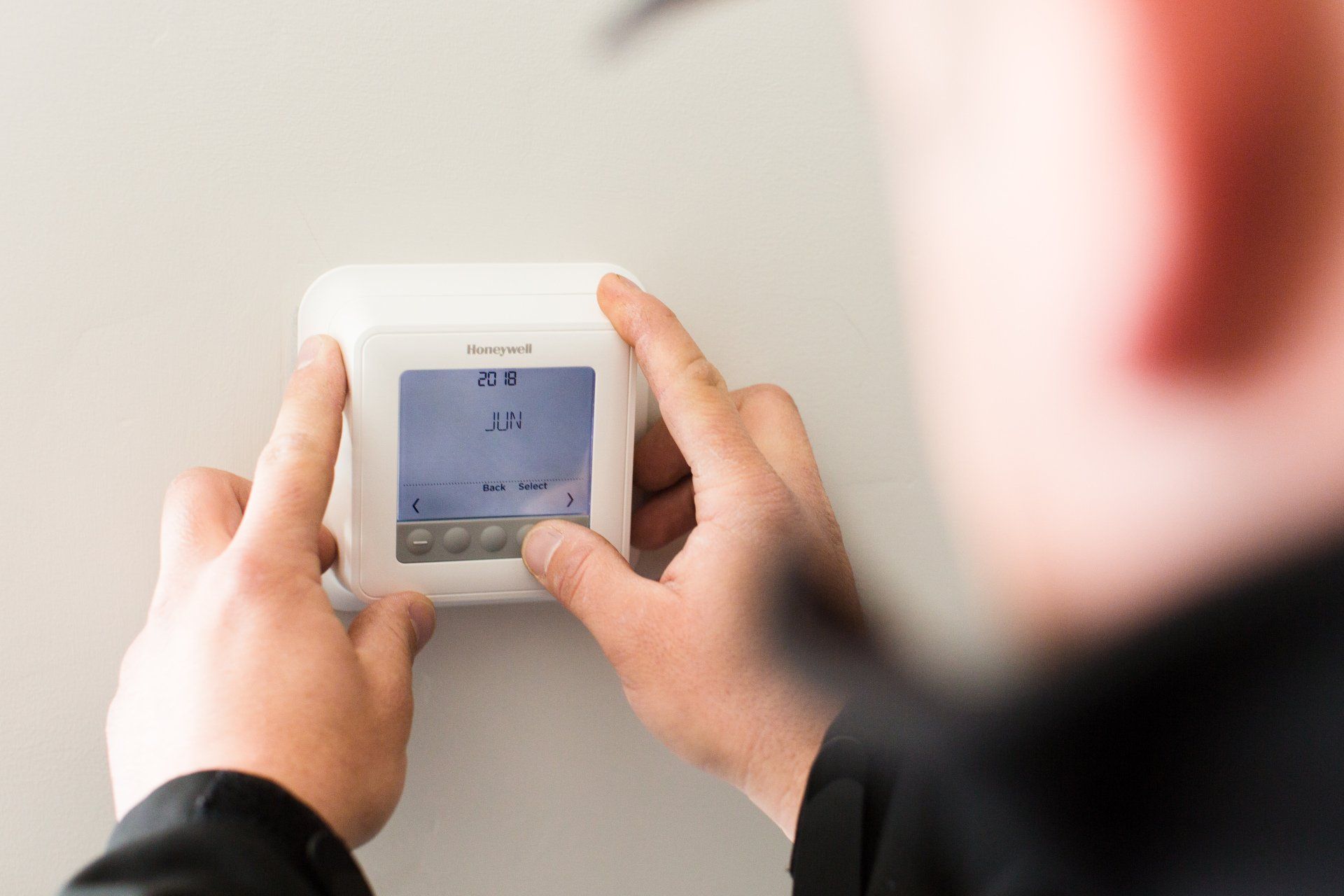Check Best Thermostat Pricing in Amazon
** As an Amazon Associate, I earn from qualifying purchases.
To recalibrate a thermostat, first, turn off the device. Then, access the settings menu to adjust the calibration.
A thermostat regulates your home’s temperature, ensuring comfort and efficiency. Over time, it may require recalibration to maintain accuracy. This process involves checking the device against a reliable thermometer and adjusting settings accordingly. Regular recalibration ensures your heating and cooling systems operate efficiently, saving energy and reducing costs.
By keeping the thermostat accurate, you also enhance your home’s overall comfort. Most modern thermostats have user-friendly interfaces, making recalibration straightforward. Proper maintenance of your thermostat extends its lifespan and improves your HVAC system’s performance. Always refer to the manufacturer’s instructions for specific guidance on recalibrating your particular model.
- Introduction To Thermostat Recalibration
- Identifying Your Thermostat Model
- Preparation Steps Before Recalibration
- Step-by-step Recalibration Process
- Troubleshooting Common Issues
- Testing The Thermostat Post-recalibration
- When To Seek Professional Help
- Maintaining Your Thermostat Long-term
- Frequently Asked Questions
- Conclusion
Introduction To Thermostat Recalibration
Keeping your home at the right temperature is crucial. A well-calibrated thermostat ensures comfort and energy efficiency. Over time, thermostats can become inaccurate. Regular recalibration helps maintain the desired temperature. This guide provides essential steps for thermostat recalibration.
Signs Your Thermostat Needs Attention
There are several indicators that your thermostat requires recalibration:
- Inconsistent Room Temperature: Rooms feel warmer or cooler than the thermostat setting.
- Frequent HVAC Cycling: Heating or cooling system turns on and off too often.
- High Energy Bills: Unexplained increase in energy consumption.
- Unresponsive Thermostat: Delayed or no response when adjusting settings.
Benefits Of Regular Thermostat Maintenance
Maintaining your thermostat offers several advantages:
- Energy Efficiency: A calibrated thermostat helps reduce energy waste.
- Improved Comfort: Accurate temperature settings ensure a comfortable living environment.
- Extended HVAC Lifespan: Reduced wear and tear on heating and cooling systems.
- Lower Utility Bills: Decreased energy usage leads to cost savings.
| Problem | Solution |
|---|---|
| Inconsistent Temperature | Recalibrate the thermostat |
| High Energy Bills | Check thermostat accuracy |
| Frequent HVAC Cycling | Adjust thermostat settings |
| Unresponsive Thermostat | Reset or replace the thermostat |
Identifying Your Thermostat Model
Knowing your thermostat model is the first step in recalibrating it. Different models have different settings and procedures. Identifying your model accurately ensures you follow the correct steps.
Types Of Thermostats
Thermostats come in various types. Each type has unique features and settings.
| Type of Thermostat | Description |
|---|---|
| Manual Thermostat | Basic model with simple controls. Requires manual adjustments. |
| Programmable Thermostat | Allows you to set schedules. Offers more precise temperature control. |
| Smart Thermostat | Connects to Wi-Fi. Can be controlled via smartphone or voice commands. |
Locating The Model Information
Finding the model information is crucial. This helps you follow the correct recalibration steps.
- Check the Thermostat Body: Look at the front or back of the thermostat. The model number is often printed here.
- Consult the User Manual: User manuals usually list the model number on the cover or first page.
- Manufacturer’s Website: Visit the website and search for your thermostat. The model number should be listed in the product details.
By correctly identifying your thermostat model, you can ensure accurate recalibration. This helps maintain a comfortable home environment.
Preparation Steps Before Recalibration
Before you recalibrate your thermostat, it is crucial to prepare correctly. Proper preparation ensures safety and accuracy. Follow these steps to get ready for recalibration.
Safety First: Turning Off Power
The first step is to turn off the power to your thermostat. This prevents accidents and ensures your safety.
Locate the circuit breaker connected to your thermostat. Switch it to the “off” position. This action cuts the power supply.
Double-check that the thermostat is off. Try adjusting the temperature. If the display remains blank, the power is off.
Gathering Necessary Tools
You need a few tools for recalibration. Gather these tools before starting:
- Flathead screwdriver
- Phillips screwdriver
- Thermometer
- Soft brush or cloth
| Tool | Purpose |
|---|---|
| Flathead screwdriver | To remove the thermostat cover |
| Phillips screwdriver | To adjust screws inside the thermostat |
| Thermometer | To check the room temperature |
| Soft brush or cloth | To clean any dust inside the thermostat |
Ensure you have a well-lit workspace. Good lighting helps you see small components clearly.
Once you have all the tools, you are ready to begin the recalibration process.

Credit: www.wikihow.com
Step-by-step Recalibration Process
Recalibrating your thermostat ensures it reads the correct temperature. This can save energy and money. Follow this step-by-step guide to recalibrate your thermostat easily.
Accessing The Settings Menu
First, access the thermostat’s settings menu. Look for the settings button on the main screen. Press it to enter the menu.
Some thermostats have a touchscreen. For these, tap the screen to wake it up. Then, find and select the settings icon.
If your thermostat has physical buttons, use them to navigate. Press the menu button, then scroll to settings.
Adjusting Calibration Settings
Once in the settings menu, locate the calibration option. This is usually under a sub-menu called “advanced settings” or “system settings”.
Follow these steps to adjust the calibration:
- Select the calibration option.
- Use the up and down buttons to adjust the temperature.
- Compare the thermostat reading with an accurate thermometer.
- Adjust until both readings match.
- Press save or done to confirm the changes.
Some thermostats might require a password to access these settings. Refer to the user manual if needed.
| Thermostat Model | Settings Access | Calibration Adjustment |
|---|---|---|
| Model A | Menu > Settings | Up/Down Buttons |
| Model B | Touchscreen > Settings Icon | Touchscreen Slider |
| Model C | Physical Buttons > Menu | Up/Down Buttons |
Recalibrating your thermostat is simple. Follow these steps to ensure your home stays comfortable and efficient.
Troubleshooting Common Issues
Recalibrating a thermostat can fix many problems. This section covers common issues and solutions.
When The Thermostat Won’t Respond
A thermostat that doesn’t respond can be frustrating. Here are some steps to fix it:
- Check the power source: Ensure the thermostat is getting power. Replace batteries if needed.
- Inspect the wiring: Loose or damaged wires can cause issues. Tighten or replace wires.
- Reset the thermostat: Sometimes a simple reset can solve the problem. Follow the manufacturer’s instructions.
Handling Inaccurate Temperature Readings
Inaccurate readings can make your home uncomfortable. Follow these steps to correct the problem:
Check Best Thermostat Pricing in Amazon
** As an Amazon Associate, I earn from qualifying purchases.
- Clean the thermostat: Dust and dirt can affect readings. Use a soft cloth to clean the device.
- Reposition the thermostat: Place it away from direct sunlight or drafts. This helps get accurate readings.
- Calibrate the thermostat: Follow the manual to adjust settings. This ensures the right temperature.
Here’s a quick table for your reference:
| Issue | Solution |
|---|---|
| Thermostat won’t respond | Check power, inspect wiring, reset thermostat |
| Inaccurate temperature readings | Clean device, reposition, calibrate |
By following these steps, your thermostat should work perfectly. Keep your home comfortable with a well-calibrated device.

Credit: www.gshomeservices.com
Testing The Thermostat Post-recalibration
After recalibrating your thermostat, it’s crucial to test it. This ensures your HVAC system works efficiently. Below are steps to follow.
Ensuring Accuracy
Verify the temperature reading on your thermostat. It should match the room’s actual temperature. Use a reliable thermometer for this.
Place the thermometer near the thermostat. Wait for a few minutes. Compare the readings.
If the readings differ, recalibrate the thermostat again. Repeat this process until the readings match.
Observing The Hvac System Response
Set your thermostat to a new temperature. Observe how the HVAC system responds.
- Set the thermostat higher or lower than the current room temperature.
- Wait for the system to start heating or cooling.
- Check if the system responds promptly.
The system should start within a few minutes. If it doesn’t, there may be an issue. Recheck the thermostat settings.
| Action | Expected Response |
|---|---|
| Set thermostat to higher temperature | Heating system starts |
| Set thermostat to lower temperature | Cooling system starts |
After testing, your thermostat should work accurately. This ensures your home stays comfortable all year round.
When To Seek Professional Help
Recalibrating a thermostat can sometimes be tricky. While many tasks can be done yourself, there are moments when seeking professional help is essential. Knowing when to call an expert can save you time and money, and ensure your home stays comfortable.
Complex Recalibration Tasks
Some recalibration tasks are too complex for a DIY approach. For instance, adjusting the thermostat’s internal wiring requires expert knowledge. Incorrect handling can lead to serious damage or even pose safety risks.
Another task that might need professional help is recalibrating smart thermostats. These devices often involve software updates and specific configurations. An expert can ensure everything works perfectly and integrates with your smart home system.
Dealing With Persistent Problems
If your thermostat issues persist despite recalibration attempts, it’s time to call a professional. Consistent temperature fluctuations or erratic behavior could indicate underlying problems.
Professionals can diagnose and fix these issues efficiently. They have the right tools and expertise to identify problems that are not visible to the untrained eye.
| DIY Recalibration | Professional Recalibration |
|---|---|
| Basic adjustments | Internal wiring |
| Battery replacements | Smart thermostat updates |
| Simple error fixes | Persistent issue diagnosis |
- DIY Recalibration Tasks:
- Basic adjustments
- Battery replacements
- Simple error fixes
- Professional Recalibration Tasks:
- Internal wiring adjustments
- Smart thermostat updates
- Diagnosing persistent issues
Maintaining Your Thermostat Long-term
Maintaining your thermostat long-term is essential for ensuring it works efficiently. Regular maintenance can extend its lifespan and save energy. Follow these tips to keep your thermostat in top condition.
Regular Cleaning And Care
Clean your thermostat regularly to ensure it works correctly. Dust and dirt can affect its performance.
- Turn off the power before cleaning.
- Use a soft cloth to wipe the exterior.
- Remove the cover to clean inside gently.
- Check for any loose wires and secure them.
Avoid using harsh chemicals. They can damage the thermostat’s sensitive components.
Scheduling Professional Inspections
Schedule professional inspections to maintain your thermostat’s efficiency. Experts can spot issues you might miss.
- Annual inspections help catch problems early.
- Professional cleaning ensures thorough maintenance.
- Calibrations by experts keep the thermostat accurate.
- Repair services can fix any detected issues.
Professional help ensures your thermostat stays in optimal condition. This can save you money on energy bills.

Credit: www.youtube.com
Frequently Asked Questions
How Do I Know If My Thermostat Is Calibrated Correctly?
Check your thermostat’s accuracy by comparing it with a reliable thermometer. Ensure both readings match. Adjust if needed.
Does A Digital Thermostat Need To Be Calibrated?
Yes, a digital thermostat may need calibration. Regular calibration ensures accurate temperature readings and efficient system performance. Consult your thermostat’s manual for instructions.
How Do I Know If My Thermostat Is Reading Correctly?
Compare your thermostat reading with a reliable thermometer. Ensure it’s placed near the thermostat. Check for consistent discrepancies.
Can I Calibrate A Honeywell Thermostat?
Yes, you can calibrate a Honeywell thermostat. Access the settings menu and follow the calibration instructions in the user manual.
Conclusion
Recalibrating your thermostat ensures optimal energy efficiency and comfort. Follow the steps outlined to maintain accurate temperature readings. Regular checks prevent costly energy bills and improve home comfort. Keep your thermostat in top condition for a cozy, efficient home environment.
Stay proactive with maintenance to enjoy consistent, accurate temperatures year-round.
Check Best Thermostat Pricing in Amazon
** As an Amazon Associate, I earn from qualifying purchases.


